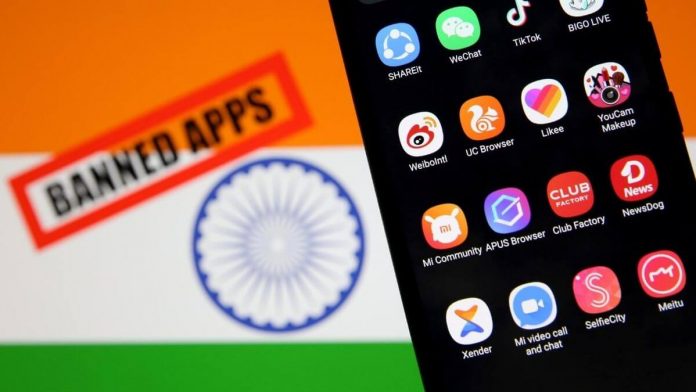This article is written by Ayushi Sinha.
Table of Contents
Introduction
The Government of India (GOI) has banned 118 apps of Chinese Origin since June 29, 2020 like TikTok, SHAREIt, UC Browser, CamScanner, Helo, Weibo, WeChat and Club Factory, naming a few.[1] This declaration by the GOI met with varied reactions and reviews ranging from a section of the populace hailing it as a fitting reply to the ‘misadventurism’ by the Chinese at the Galwan Border in Ladakh to another section who perceived this rebuttal as a mere symbolic retaliatory measure. The latter even went in so far as to gauge the suitability in the backdrop of strategic and economic prudence. The tenability in the context of global trade bodies like World Trade Organisation (WTO) and the susceptibility before the law of the land are all being fiercely debated. This article proposes to understand the effect and lacunas of such mass ban imposed by the Indian Government.
Impact on sections of populace
A huge population close to about 10 crores active users of TikTok in India, one of the forefront and famous apps among the total 118 Chinese apps banned, is purported to be adversely affected.[2] It is alleged that the rural and marginalised section of the population have become used to being online through the usage of these user friendly apps and also with telecom sector doling out affordable combo offers of internet services with call facilities, these have become their second nature. Even the remotest of artisans, theatre artistes, small businessmen, even general public had been sharing their talent, skill, offerings and sometimes even idiosyncrasies’ thereby expressing themselves in an emancipative manner through these broadcasts. Further, it created opportunities to showcase their offerings with ardent hope of being noticed, identified and progressed in the world of digital validation and associated commercials. This nature of exposure was earlier only privy to some privileged and social capital blessed individuals and groups only. With social exclusion in physical form, following the pandemic, it also provided a welcome relief to share, explore and connect.
With Facebook or WhatsApp banned in China and Tibet, Chinese app WeChat which was the sole video connecting platform for the Indian enrolled students and Tibetan refugees to remain in touch with their families and friends back in India/Tibet. Chinese tech giants have also raised concerns over this discriminate treatment. They maintained that keeping Art.19(1)(a) of The Constitution of India, 1950, apropos freedom for expression and dissemination of information, there is sufficient ground to a constitutional challenge to the ban. This means that the manner in which the geo block, a technological measure which restricts access to content based on the user’s IP address, is imposed should not be arbitrary leading to violation of one’s fundamental right. It should tantamount to access by the State to the internet in violation of the fundamental right to privacy enriched under Article 21.[3] Such ban leading to indefinite suspension of such internet platform could amount to an abuse of power. A geo-block abrogates the fundamental right to access the internet. To invoke ‘Reasonable restriction’ Article 19(2), in the context of public order and national security, due care must be taken to ascertain if it remains fair, just and reasonable under Article 14.[4]
Differentiation or discrimination
It has also been opined that the dissimilar treatment between Chinese apps and similarly placed American apps can be justified only on the basis of some lucid difference or if it has a bearing with the objective it aims to achieve. The notification cannot treat Chinese investors (i.e. app developers) any differently on grounds of cybersecurity, misinformation, etc.
Chinese apps are hardly alone in the mass collection. US companies like Facebook, Uber and Amazon seeks personal data to enable download and Chinese tech giants are no way different. India’s own Reliance Jio operates much the same way. This differential treatment portrays an arbitrary and unfair opportunity in the realm of the Internet. Additionally, the restriction must not be on access to the applications all together but at best can be allowed on certain limitations. The decision to mass block 118 Chinese apps without any classification may render the process constitutionally untenable, impermissible subject to constitutional inquiry.
The government perspective
The contra view on the subject is that the GOI is well within its powers to impose narrow restrictions towards access to content. In Anuradha Bhasin v. Union of India & Ors.,[5] the Supreme Court admitted that Section 69A read with the Information Technology (Procedures and Safeguards for Blocking for Access of Information by Public) Rules, 2009 bestows this power to GOI.
Further, In Shreya Singhal v. Union of India & Ors.,[6] it has been maintained that the constitutionality of section 69A, on what it is based on, is not unconstitutional i.e., it should pass the test of that it pursues a legitimate interest, is suitable (i.e. there has to be a rational connection between the means adopted and the object sought to be achieved), is necessary (the means adopted must not be excessive, i.e. it should be the least intrusive measure in the given set of circumstances and is proportionate (i.e. the balance between the interest in restricting the right must override the need to safeguard the right). “The data compilation, its mining and profiling endangering the national security and defence of India, impinging upon the sovereignty and integrity of India, is a matter which justifies resorting to emergency measures…There have been raging concerns on aspects relating to data security and safeguarding the privacy of 130 crore people. The Indian Cyber Crime Coordination Centre, part of the Ministry of Home Affairs, has sent an ‘exhaustive recommendation for blocking the malicious apps’” the press release said.[7]
The GOI also maintained concerns which have been raised by several citizens who have represented to the Indian Computer Emergency Response Team (CERT-In) regarding security of data and loss of privacy while using these apps. Besides, Home Ministry’s Indian Cyber Crime Coordination has contended that the Chinese apps (including Helo and SHAREIt) seek relatively excessive information such as access to microphones, cameras and GPS location information which is not a prerequisite or necessary to render a particular service.
The Press Information Bureau (PIB) notification, under section 69A of the Information Technology Act, 2000 read with the Blocking rules, 2009, gives reasons for such ban is being based on the justification that these apps are engaged in activities which are prejudicial to user privacy and the sovereignty of India.[8]
An alternate approach
It needs to be assessed whether the regulatory framework to evaluate the app ban in light of the provisions of the General Agreement on Trade in Services (GATS) or General Agreement on Tariffs and Trade (GATT). These technological censorships were perhaps not thought of by the drafters of these agreements. As a result, being out of the gambit of WTO, sovereign prerogative to use as they deem fit seems to be the only way out.
Threats of taking the censorship matter to the WTO may not qualify to be considered a trade barrier since products are often blocked at borders of many countries without creating trade disputes.
The world is concerned over the Chinese hegemony and expansionism tactics with moves like the ‘Belt and Road’ Initiative which all may help in securing global legitimacy for India. Politically speaking, US and France have already voiced their support on the ban by India and trade sanctions are unlikely even if there is an adverse adjudication by the WTO. Effectively, US followed the path led by India but instead of banning completely, they suggested reorganisation of TikTok under US-controlled company (Though the same is yet to be approved by the Chinese government).[9]
It will be in place to mention here that India needs to invest more on the South Asian diplomacy by garnering soft power and reviving SAARC, if it wants to maintain its hegemony and dissolve border disputes without any commercial loss and threat to its democracy. Further, it is learnt that GOI will exclude Chinese technology companies like Huawei and ZTE from India’s 5G network race, and also tariffs on Chinese-made goods are to be revised upwards.[10]
While, it is understandable for GOI to hold its ground against Chinese expansionism, and to use a minimal technological measure as detriment may be well-intentioned, it may at best be a no-nonsense or don’t-mess-with-us gesture pressurising the Chinese side to be sincere in completing the disengagement of troops along the Line of Actual Control. But stretching it too far to sever trade relations without adequate substitution and domestic readiness would be reckless and would end up with a boomerang effect. ‘Make In India’ and other self-reliance campaigns of India are yet to take off on ground. Perhaps this jolt will give the right impetus to implement on ground the vision of India — turning crisis into opportunity – and is going to prove equally effective for our resolve of ‘Atma Nirbhar’ or self-reliant India through more local manufacturing…a blessing in disguise.
Conclusion
One should realise that these prohibited apps don’t have any vital impact on the Chinese stake within the Indian economy. Chinese capital notably within the education and pharmaceutical sector, toys, chemicals, electrical and physical science, piece of furniture etc. is therefore profound including Chinese technology corporations and working capital players have acquired a minority or dominant stakes in Indian Unicorns/Start-ups and firms and that an economic warfare will be in disfavour of India’s interests at massive.
China has created deep digital inroads by means of investments in start-ups over the past 5 years to penetrate India’s on-line scheme with its widespread smartphones and apps, while it was not able to persuade India to hitch hike in its Belt and Road Initiative. Conversely, our stakes in Chinese economy are minimal. For instance, China accounted for over five percent of India’s total exports in year 2019-20 and more than 14% of imports. Meaning, India runs a large trade deficit with China, the largest exporter to India.[11] It is not possible to stop trading with China immediately. We need to strategically replace by import substitution and/or other countries. At present close to 80% of India’s imported active pharmaceutical ingredients come from China.[12] On the pharmaceuticals and textiles front, Vietnam is willing to collaborate with India and a regional supply chain can be developed with Indonesia.[13]
Let the adversarial position be restricted to ban of apps, per se, and that these won't impact our economy critically however on the other side, the ban has egged the domestic apps with an enormous acceptance rate. The rate of downloads have soared for apps such as Chingari, Roposo (India’s answer to TikTok) which saw its downloads rise to over ten million and fifty million on Google Play Store before long when the ban on Chinese apps was declared.[14]
Similarly, India-made Zoho Doc is stepping into the shoes of Camscanner.[15] Reliance launched conferencing app JioMeet in competition to Zoom, though US based entity has major Chinese interests in it.[16] The token protest is well placed keeping in mind that Chinese app firms might receive little or no data from the Indian government regarding the explanation for such act. If the ban is to be turned the sole means would be to somehow persuade the Indian government that the Chinese apps won’t enable any information of their Indian users to be stored/transmitted outside India, particularly to foreign governments.
Bans maintained under Section 69A of the IT Act being turned by the committee is unbelievably rare to examine at the primary instance, though the blocking orders had been reconsidered and overturned after the lapse of some time. The govt. doesn’t unleash a lot of data regarding such orders however from the legal perspective, national security is the ground taken by GOI in court and therefore, the same is extremely troublesome to be challenged within the court of law.
Perhaps realising these scheme, TikTok has processed that they don’t intend to proceeding legally as of then. It was reiterated that they’re going to comply with the Indian law and are determined to be operating with the govt. to reason out a solution against the objections or concerns.[17] Not to be omitted that the oversight of on-line data could is quite a common feature within the legal frameworks of the many countries. Chinese firewalls (The Great Firewall of China) is illustrious for its clamp to stop the misuse of its digital public spheres offer with no scope for review[18] No wonder, China’ss stand has also softened off late. Their ambassador tweeted that his country advocates win-win cooperation and opposes zero-sum games. He said, “Our economies are highly complementary, interwoven and interdependent”.
Forced decoupling is against the trend; will only lead to a lose-lose outcome.[19] Therefore, both the sides need to deescalate both at the border and on the app issue as irrespective of the controversy surrounding the legitimacy of the overall act of banning of the Chinese apps, the legal recourse of a commercial body against a Government that too on a subject of national integrity and sovereignty is a difficult proposition for the tech companies. Added to it is the worthwhileness of souring on commercial side besides the face off at the border without any foreseeable gains is impractical and imprudent.
References
- The Hindu Explains| ‘What will be the impact of Chinese apps ban?’ July 05, 2020 K. Bharat Kumar. https://www.thehindu.com/news/national/the-hindu-explains-what-will-be-the-impact-of-chinese-apps-ban/article31991127.ece
- The wire | ‘Examining the Legal and Policy Process Behind India's Ban on Chinese Apps…’, 7th July, 2020. https://thewire.in/tech/india-ban-chinese-apps-tiktok-legal
- The Constitution of India, 1950
- Ibid
- WP(C) 1031/2019
- (2013) 12 S.C.C. 73
- Economic Times Tech ET Bureau | ‘India bans 59 Chinese apps including TikTok, WeChat, Helo..’29 July, 2020 https://economictimes.indiatimes.com/tech/software/india-bans-59-chinese-apps-including-tiktok-helo-wechat/articleshow/76694814.cms
- The Wire | ‘ Where does India’s Ban on Chinese Apps fit into the Global Trade Debate’, July 5, 2020, https://thewire.in/tech/india-china-apps-global-trade-debate
- Sky News | ‘TikTok: Deal to prevent app from being banned in the US is plunged into peril’, Tuesday, 22 September 2020, https://news.sky.com/story/tiktok-deal-to-prevent-app-from-being-banned-in-the-us-is-plunged-into-peril-12078409
- Nikkei Asian Review, ‘Indian apps soar after ban on China's TikTok, WeChat and Baidu’ 4 AUGUST, 2020,HTTPS://ASIA.NIKKEI.COM/SPOTLIGHT/ASIA-INSIGHT/INDIAN-APPS-SOAR-AFTER-BAN-ON-CHINA-S-TIKTOK-WECHAT-AND-BAIDU
- Bloomberg: Quint| ‘Six things to know about India-China Economics Relations’, June 20, 2020, https://www.bloombergquint.com/economy-finance/six-things-to-know-about-india-china-economic-relations
- The Times of India| ‘China supplies over 80% of pharma raw materials’, June 19, 2020, https://timesofindia.indiatimes.com/business/india-business/china-supplies-over-80-of-pharma-raw-materials/articleshow/76453541.cms
- Hanoi Times | ‘Vietnam- India: New Partnership in Supply Chain’, Aug 19, 2020, http://hanoitimes.vn/vietnam-india-new-partnership-in-supply-chain-313919.html
- The Indian Express| ‘Tiktok ban: Homegrown chingari, Mitron, Roposo, Sharechat see urge in downloads’, July 5, 2020 https://indianexpress.com/article/technology/tech-news-technology/tiktok-ban-indian-apps-chingari-mitron-roposo-sharechat-surge-downloads-6488547/
- The Hindu: Business | ‘Zoho unveils desi version of China’s CamScanner app’, July 4, 2020https://www.thehindu.com/business/zoho-unveils-desi-version-of-chinas-camscannerapp/article31973711.ece#:~:text=Software%20developer%20Zoho%20Corporation%20has,is%20available%20free%20of%20cost.
- Gadgets 360: NDTV| ‘JioMeet: Reliance Jio launches free video conferencing on Zoom’, July 3, 2020 https://gadgets.ndtv.com/apps/news/jiomeet-reliance-jio-launches-zoom-competitor-video-conferencing-app-2256165
- India Today| ‘Tiktok says no plan to take legal action against the ban’, July 3, 2020, https://www.indiatoday.in/technology/news/story/tiktok-says-no-plans-to-take-legal-action-against-the-ban-1696546-2020-0703#:~:text=TikTok%20had% 20 sai d % 2 0that%20it,%2C%20TikTok%2C%20CamScanner%2C%20Shareit
- Human Rights watch reports | ‘How censorship works in china: A brief overview’, August 2006, https://www.hrw.org/reports/2006/china0806/3.htm
- The Economic Times | ‘China warns India against ‘forced decoupling’ of their economies’, July 31, 2020'https://economictimes.indiatimes.com/news/international/world-news/china-warns-india-against-forced-decoupling-of-their-economies/articl es how/7726 4606.cms?from=mdr
LawSikho has created a telegram group for exchanging legal knowledge, referrals and various opportunities. You can click on this link and join:













